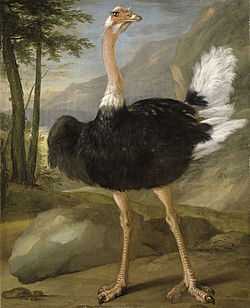Nicasius Bernaerts
Nicasius Bernaerts, Monsù Nicasio or simply Nicasius[1](1620, Antwerp – 1678, Paris) was a Flemish painter of animals, hunting pieces and flowers who had an international career in Italy and Paris.[2]
Life
Bernaerts was a pupil of Frans Snyders in Antwerp. He travelled around Italy and France and worked in Paris for a number of years around 1643. He returned to Antwerp where he became a master of the Guild of Saint Luke in 1654.[2]
In 1659 he moved to Paris. He was admitted into the Royal Academy of Painting and Sculpture in Paris in 1663.[3] He was employed by the French king Louis XIV to make paintings of all the new animals added to his menagerie at Versailles. [4] In 1673 Bernaerts provided 46 studies of 52 species of animals. Some of these paintings were subsequently used to decorate the pavilion at the menagerie. He then entered the service of the royal administration and provided studies and animal paintings for the needs of the Gobelins Manufactory and royal real estate office (Garde-Meuble de la Couronne).[3]
He was later reduced to poverty as a result of alcoholism and died in poverty in 1678.[3]
The French animal painter Alexandre-François Desportes was his pupil.
Work

Nicasius Bernaerts painted animals, hunting pieces, including game pieces, and still lifes.[2]
In his paintings of the animals from the menagerie at Versailles, Bernaerts presented his subjects with a pedagogic objective. The animals are depicted in quiet poses, their bodies almost always in profile, their eyes often turned to the viewer, as in portraits of humans. This posing of the animal allows the viewer to better observe the anatomy of each animal. Each creature is set against a classicizing landscape background. [5]
There is uncertainty regarding the actual authorship of the numerous unsigned oil-sketches that came to the Louvre during the French Revolution and were listed as 'A.F. Desportes' originally and then distributed as such about a century ago to French provincial museums. An old Gobelins-inventory, which was rediscovered in 1967, shows that a number of these works were produced by the generation of artist preceding Desportes such as Nicasius Bernaerts. It is assumed that among the works now given to Bernaerts at the Louvre a number must be authentic, most probably the nicely done, rather antiquated portraits of different poultry races.[2]
References
- ↑ Variant name spellings: Niçaise Beernaert, Nicasius Bernaerds, Nicasius Bernaert, Nicasius Beenaers
- ↑ 2.0 2.1 2.2 2.3 Nicasius Bernaerts at the Netherlands Institute for Art History (Dutch)
- ↑ 3.0 3.1 3.2 Nicasius (ou Nicaise) Bernaerts (Anvers 1620 - Paris 1678)
- ↑ Morton, edited by Mary (2007). Oudry's Painted Menagerie: portraits of exotic animals in eighteenth-century France. Los Angeles, Calif.: Getty Museum. p. 70. ISBN 9780892368891.
- ↑ Cerf du Gange (Nicasius Bernaerts), musée de la vènerie de Senlis
| Wikimedia Commons has media related to Nicasius Bernaerts. |